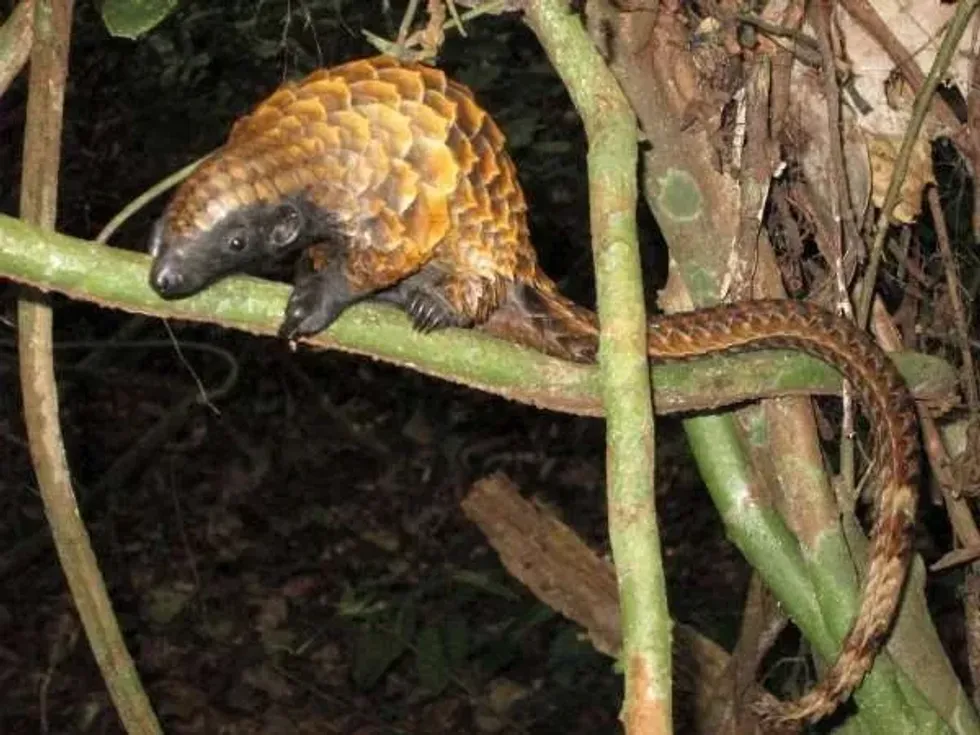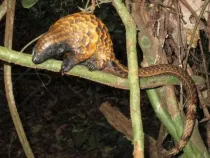Have you ever seen a mammal with scales? If not then the pangolin is the only mammal with scales.
It is because of this peculiarity that this unique mammal is frequently confused with reptiles. These scales are made of keratin.
When threatened the species of pangolin rolls up into a ball. There are eight species of pangolin. Out of which four can be found in the continent of Asia including the Indian pangolin (M. crassicaudata), Chinese pangolin (M. pentadactyla), Philippine pangolin (M. culionensis), Sunda pangolin (M. javanica).
While, four others can be found in the African continent including the White-bellied pangolin (P. tricuspis), Temminck's Ground pangolin (S. temminckii), Giant Ground pangolin (S. gigantea), and the Black-bellied pangolin (P. tetradactyla) or the long-tailed pangolins. Pangolins are mainly nocturnal and the conservation status of the Pangolin species can range from being vulnerable, endangered to critically endangered.
However, the long-tailed pangolin species are diurnal and arboreal. This pangolin is distinguished for its incredibly long tail and the dark hair on the underside of its limbs and body.
If you like this article then you would like our other articles on Indian pangolin facts and Sunda pangolin facts!
Long-tailed Pangolin Interesting Facts
What type of animal is a long-tailed pangolin?
Pangolins are acknowledged as scaly anteaters because of the presence of scales on their body. They are the only mammals that have a scale-covered body. This characteristic makes the pangolins one of the most extraordinary animals. The long-tailed pangolin is one of the species of the pangolin that has an extremely long tail.
What class of animal does a long-tailed pangolin belong to?
Long-tailed pangolins belong to the class of Mammalia.
How many long-tailed pangolins are there in the world?
Long-tailed pangolins are a vulnerable species, but an exact number of them is not listed.
Where does a long-tailed pangolin live?
It is only in the continent of Africa that pangolins can be found. The geographical range of the pangolins covers the central and eastern regions of Africa. These areas incorporate Senegal, Uganda, the Republic of the Congo, Equatorial Guinea, the Central African Republic, Togo, Cameroon, Sierra Leone, Gambia, Guinea Bissau, Ghana, Ivory Coast, Nigeria, Liberia, and Benin.
What is a long-tailed pangolin's habitat?
The long-tailed pangolin's habitat comprises moist and tropical riverine, rainforest, and the swamp forests of the African continent. It is an arboreal mammal and chiefly lives in trees. It also resides near the agricultural region within the rainforest. The tree pangolin lives near water bodies and is a good swimmer. It never leaves the forested area.
Who do long-tailed pangolins live with?
Long-tailed pangolins are solitary mammals. It is only during mating that the pangolins interact with one another.
How long does a long-tailed pangolin live?
The approximate lifespan of long-tailed pangolins is not listed. Their major predators include pythons, leopards, and humans.
How do they reproduce?
Long-tailed pangolins are mainly solitary and shy. It is only during mating that they come into contact with other pangolins. The exact breeding season of the pangolins is not listed because they mate throughout the year.
Nevertheless, the process of reproduction is sexual. The male and female pangolins copulate by intertwining their tails. The gestation period can range from 120-150 days after that the female gives birth to one offspring.
What is their conservation status?
The conservation status of the long-tailed pangolin (Phataginus tetradactyla) according to the International Union for Conservation of Nature is Vulnerable.
The vulnerable status is not just for long-tailed pangolins, but other pangolins of Africa and Asia such as the Temminck's ground pangolin, giant ground pangolin, Indian pangolin, and the Chinese pangolin, which are all under threat due to human activities.
Long-tailed Pangolin Fun Facts
What do long-tailed pangolins look like?

Long-tailed pangolins appear extraordinary because of their black belly. The underside of its body is covered in dark fur. Reaching approximately 12–16 in (30–40 cm), these pangolins resemble anteaters.
However, they are comparatively smaller. The male pangolins are bigger than the female pangolins. Another incredible feature is their tail which is around 24–28 in (60–70 cm) long. Their tail consists of 46-47 caudal vertebrae that are unusual in a mammal.
On the tip of their tail, there is a sensory pad that enables the pangolins to grip branches. The pangolins have long sticky tongues and no teeth. The scales of the Pangolins are dark brown and assist them in camouflaging.
How cute are they?
The long-tailed pangolins are small compared to other pangolins hence they are cute. The extraordinary appearance and the presences of scales make them a unique species.
How do they communicate?
The long-tailed pangolins are solitary animals. They have a great sense of smell and pheromone enables them to find a mate. It is only during mating they communicate with each other. However, the mating period is extended throughout the year.
How big is a long-tailed pangolin?
The long-tailed pangolin is the smallest of all the species of pangolin. The approximate size of these pangolins is 12–16 in (30–40 cm). The white-bellied pangolin is 23.6-41.3 in (60-105 cm) which is double the size of long-tailed pangolins.
How fast can a long-tailed pangolin run?
The top speed of pangolins is 3 mph (5 kph) but the exact speed of this species of tree pangolin is not yet determined.
How much does a long-tailed pangolin weigh?
The average weight of these pangolins is 4.4-5.5 lb (2.0–2.5 kg). They are the smallest of all the pangolin species. Compared to the Temminck's ground pangolin of Africa which is approximately 26.4 lb (12 kg), the long-tailed pangolins weigh very little.
What are the male and female names of the species?
There are no sex-specific names that have been assign to the male and female long-tailed pangolins.
What would you call a baby long-tailed pangolin?
The females can give birth to one offspring which is called a pup. The pups are initially born with soft scales that tuns hard after few days. These arboreal animals become adults after 15 months.
What do they eat?
Their diet is similar to ant-eaters, which is another reason why they are being called scaly anteaters. They survive mainly on ants. The long-tailed pangolin utilizes its sense of smell to track down the nest of ants. They rip up the nest of the ants and then with the help of their long sticky tongue they eat the ants.
Are they dangerous?
No, none of the species of pangolin are dangerous. They are completely harmless and have their ways to protect themselves. The scales act as a shield and they may emit some foul smell from their anus otherwise they are in no way dangerous to human beings.
Would they make a good pet?
No, even though the tree pangolin is harmless then cannot be kept in captivity. They do not do well in captivity. All the species of the pangolin are already under threat.
However, numerous initiatives are being taken to check their population. Both in the African and Asian continent they are protected under various laws. Therefore they cannot be kept as a pet.
Did you know...
One of the most trafficked mammals in Asia is the pangolin. They have an extreme demand in Vietnam and China.
The meat of a pangolin is considered to be a delicacy in numerous Asian countries.
The scales of pangolins are considered to be a traditional medicine, capable of curing several ailments. This is, of course, just a tradition and is not a replacement for modern medicine, their scales will not actually cure you of any ailment.
The term ‘pangolin’ is derived from ‘pengguling’, a Malay word for something that rolls up.
Are they dangerous?
No, the long-tailed pangolin (Manis tetradactyla) is not dangerous. These animals face immense abuse and exploitation because of their extraordinary appearance. If they feel threatened, they curl up. However, pangolins have no negative impact on humans.
Are they endangered?
Yes, they are vulnerable. The eight species of pangolins are either Threatened, Vulnerable, or Critically Endangered. Long-tailed pangolins are being subjected to trafficking which is threatening their population. There are very few pangolins left in the world. Therefore they are protected under laws like other endangered species.
Here at Kidadl, we have carefully created lots of interesting family-friendly animal facts for everyone to discover! For more relatable content, check out these marble fox facts and jackal facts for kids.
You can even occupy yourself at home by coloring in one of our free printable Arizona mammal coloring pages.
Main image by Rod Cassidy.
Second image by Rod Cassidy.









